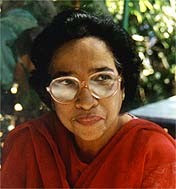The Assi Ghat in Varanasi where the River Assi joins the Ganges,
is the Alice Boner Institute, which was the home of Alice Boner a Swiss
painter, sculptor, art historian and Indologist for four decades from 1936 -1978.
It is a residential Cultural Centre for young artists to study the fundamental
principles of Indian Art and pursue Academic Research.
Alice Boner was born at Legano, Italy on 22nd
July 1889, to Swiss parents. After her basic education, she studied painting
and sculpture in Brussels, Munich and Basel between
1907-1911. By 1916, she
was an independent artist and exhibited her work at the Museum of Modern Art,
Zurich.
Alice was 47 years old when she witnessed a dance
performance by a noted Indian dancer Udaya Shankar at Kursaal, Zurich. She was
enchanted by his elegant dance movements and made quick sketches of him on
paper, which she later transformed into sculptures at her studio in the Rokoko Pavilion,
very close to the University of Zurich.
In 1929, Alice met Udaya Shankar again in Paris where he
was performing. He was planning to go to India to form a troupe of dancers and
musicians. Alice accompanied him to India. There was not much encouragement for
Udaya’s plans to take Indian dance to the West. In 1931, he and his troupe which consisted of
some of his family members, gave their first performance at Theatre des Champs
Elysees in Paris. Alice became his co-director, administrator and costume
designer. But after five years, Alice returned to India and settled down in
Varanasi in 1936.
“This place is so warm
and welcoming,” she said, “It encloses me with love and opens the world to
me…..I feel fulfilled, happy settled and supported like a gentle stream.”
The place where she
lived was called “Alice Boner Ghat” by the locals.
As her interest in Indian Art and her fascination with
the human body with its ‘intersections and tangents’ grew, she gave up
sculpting. She thought it was a slow process and she had much to study
systematically of the Sacred Scriptures and Temple Architecture. She spent
months studying the sculptures of Ellora, Mahabalipuram and Badami. Her
analytical sketches made her aware of the methods used by ancient artists to
create well proportioned figures. Her in-depth study resulted in a book “The
Principles of Composition of Hindu Sculptures,” which was published in 1968.
Inspired by the study of Shilpa Prakasha, she learnt that
the sculptures were carved around geometrical concepts and principles
underlying all temple art. These principles, she absorbed into her own art,
specially seen in her Tryptych – three large paintings titled Shristi, Sthithi
and Samskara. The paintings portrayed
people around her as well as mythological figures, as if ‘entire Creation
wanted to break forth from her subconscious.’
Alfred Wuerfel a German Sanskrit scholar said she painted from the
‘profane life around her and reached out to the sacred and numinous.’
These large paintings are displayed at the Alice Boner
Gallery in Bharat Kala Museum at the Benares Hindu University. The gallery was
set up in 1989 to mark her birth centenary. A visitor to the gallery travels
through the various phases of her life, culminating in the central Tryptych.
Each exhibit is accompanied by quotations from her books. Part of her
collection is also exhibited at the Reitberg Museum in Zurich.
In 1969 Alice received an Honorary Doctorate from the
University of Zurich. In 1974 she was awarded the Padma Bhushan, India’s third highest
civilian award.
Alice Boner lived a busy life. Apart from painting, she organized
concerts for musicians like Ali Akbar Allaudin Khan, and dancers like Shantha Rao.
She was also interested in the Kathakali dance form of Kerala. She entertained artists,
intellectuals, scientists and important men like Nehru, Tagore and even Carl Jung
the famous psychologist.
In 1937, a French musicologist and artist Alain Danielou moved
into her neighborhood. They became good friends and he described her as a ‘beautiful
woman, tall and stately, haughty and strong willed.’
In 1981 while visiting Zurich, Alice fell ill and died on
April 13th at the age of 91 years. The world has not given this truly
visionary artist her due acclaim.



